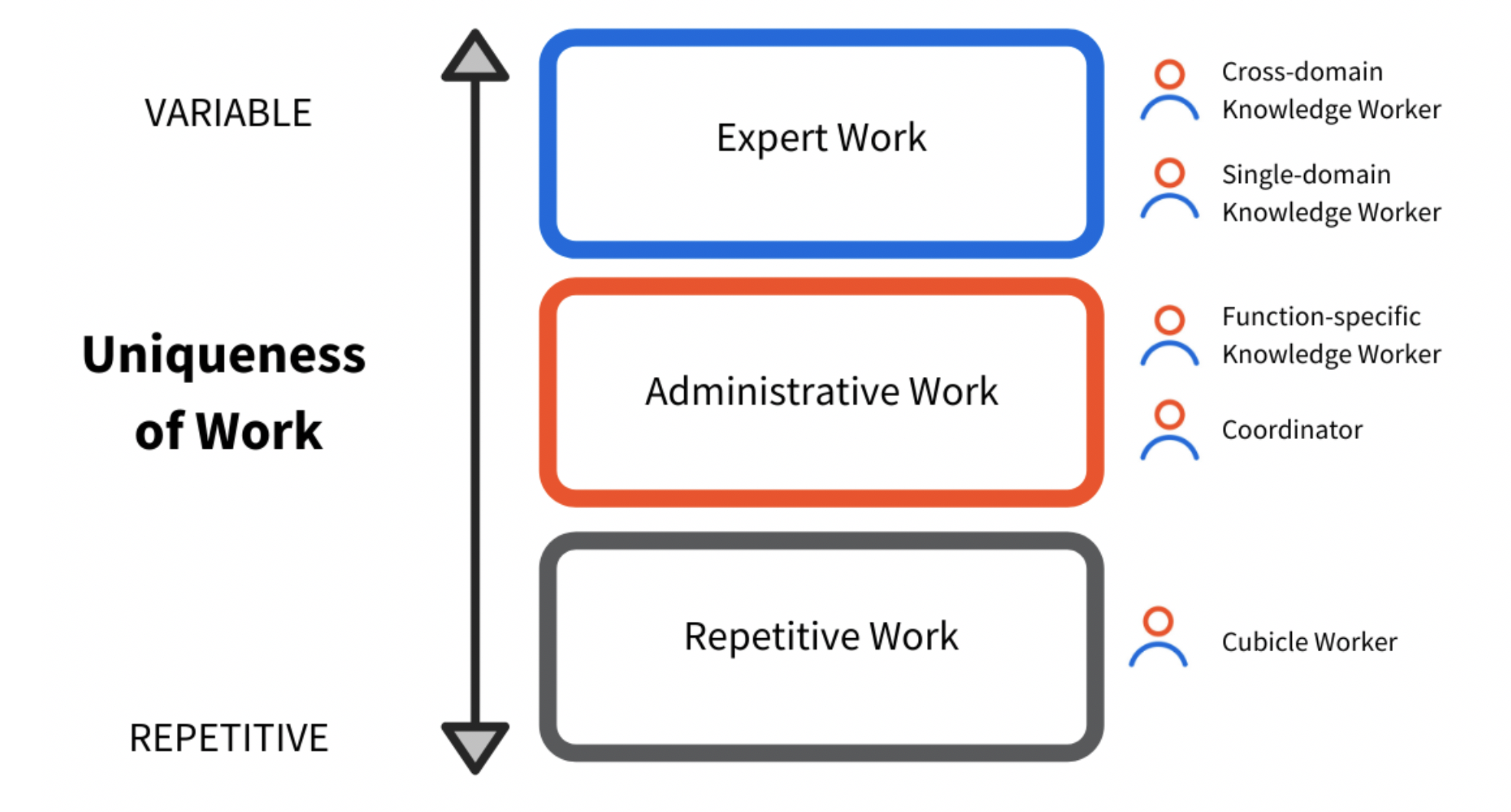To Conquer the Future of Work, Leaders Must Pick the Right Automation Tools for the Job—Here’s How
To Conquer the Future of Work, Leaders Must Pick the Right Automation Tools for the Job—Here’s How
Share at:

If you were competing in a Formula 1 race, you wouldn’t show up on the racetrack in a sedan. Similarly, it would be overkill to drive a Formula 1 race car to the grocery store. Both vehicle types are fantastic modes of transportation, but each is best suited for a unique category of driving.
Automation technologies are no different.
Note: if you're new to automation technology, we recommend you start by reading Overview of RPA for the C-Suite: The Quick Guide to Getting Started.
The automation landscape today is filled with a wide spectrum of different but complementary technologies and capabilities from Robotic Process Automation (RPA) to machine learning (ML) and artificial intelligence (AI). Combined, they create an end-to-end automation ecosystem that accelerates digital transformation while reducing costs and improving productivity.
An important part of the creation of these innovative ecosystems—and the future of work at large—is understanding how best to use these technologies together to meet your organization’s goals. After all, while a race car can be used for errands, it could also be viewed as an inefficient and overcomplicated way to do a simple task.
Similarly, mismatching levels of automation technology leads to inefficiencies. If you choose too high-level of a tool for basic task automation then you risk over engineering—and, likely, overspending on—your solution. If you choose too foundational of a tool for complex work then you risk falling short of your key performance indicators (KPIs).
To understand which part of the automation ecosystem to use for which tasks, Forrester Research suggests a model they call the “spectrum of work uniqueness.” It sounds complex, but it’s a very simple way to understand the variety of automation tools available and drive higher return on investment (ROI) as you begin to automate.
What you need to know about the unique work spectrum
Like many things in life, the complexity of the work we do exists on a spectrum. In a recent UiPath webinar, a member of Forrester Research described three categories of work uniqueness—basically, how easy or difficult it is for a software robot to replicate a task done by humans:
Repetitive work relies on rule-based tasks or repeatable processes and is the easiest for software robots to take on.
Administrative work involves more complex processes, like logistics and other back-office management, and requires a slightly more advanced level of automation technology than repetitive work.
Expert work requires decision making and strategic and creative thinking at a high level and the automation technology to match.

These categories stack to show the increasingly complex spectrum of work in modern business. Understanding how these three levels work together to support operations gives leaders a framework for understanding and applying the best automation technology for the problem at hand.
Employees along the unique work spectrum
Before we move on, we want to outline what employee roles we’re talking about. In our recent webinar, five unique personas were defined to help C-suite leaders envision the specific job description, tasks, and processes along the uniqueness spectrum, including the:
Cubicle worker. The cubicle worker performs repetitive, structured, and often lower-value tasks in back- or front-office positions.
Coordinator. The coordinator spends their work hours administrating or coordinating information, money, and/or tasks between supervisors, coworkers, or subordinates.
Function-specific knowledge worker. This worker spends their time on structured and semi-structured tasks, such as compiling, categorizing, calculating, auditing, and verifying information.
Single-domain knowledge worker. The single-domain knowledge worker offers experience, education, and skills in a specialized field or discipline, such as radiology, system administration, or social media management.
Cross-domain knowledge worker. This is the highly-skilled, cross-functional worker—such as the consultant, the executive, or the creative—who drives strategic decisions while drawing from their experience and knowledge in various specialized fields and disciplines.
Take a moment to think of the people in your organization who fit these job descriptions. Chances are, you have most, if not all, of them within your company. Keep these examples in mind as we discuss the automation technology (and technology combinations) best suited for each work type.
Repetitive work: Freeing employee hours with RPA
Repetitive work is the least unique work, the ‘busywork,’ if you will, that people in positions like the cubicle worker spend most of their time doing. Repetitive work offers a quick return on your automation investment and is the most effective at freeing up employees for higher-value tasks. Because of this, it’s an ideal place to start your automation journey. Two automation technologies in particular are transforming repetitive work and its role in business.
Automate repetitive tasks with RPA
RPA is the epicenter of automation. In brief, it works by mimicking human behavior in executing manual, rule-based tasks. RPA is a low-code solution, meaning it doesn’t require a high level of technical knowledge to implement. It provides a high return on investment, making it an ideal entry point to digital transformation.
As one of many examples, IT distributor Tarsus Distribution used RPA to save their employees five days’ worth of data entry work while experiencing 100% data capture accuracy.

Read the full Tarsus Distribution story.
Improve contact center requests with conversational understanding
The contact center is another mainstay of repetitive work. In many customer service operations, workers rely on scripts and answer the same question dozens of times a day. Conversational understanding changes that. This automation technology works alongside RPA to create chatbots that process and respond to queries in natural language.
When using conversational understanding via AI to automate contact center work, robots can escalate cases needing a human touch to your agents, who now have more time and energy to offer a better, more hands-on customer experience.
Want to learn more? Watch our on-demand webinar: Boost Your Contact Center with Front to Back Automation.
The impact on your company
By automating repetitive work, you can save employees thousands of hours of work, all while increasing accuracy. This increase in efficiency will, in turn, improve your relationship with your customers, who no longer need to wait on internal processing or to sit in a queue for technical help. It’s not just your customers and stakeholders who win, though. Automating repetitive work also results in happier and more productive employees, whose time and energy can now be reinvested in higher-value tasks.
Administrative work: Automating efficiency with process mining
Administrative work seems like unavoidable work—including tasks that support logistics, accounting, and other back-office management. The coordinator and the function-specific knowledge worker personas represent the two different roles that fall into this category. Automation is rebooting administrative work by reducing the amount of human effort needed, making it faster and more efficient.
Streamline document and invoice management with text analysis technology
Paperwork is at the center of many administrative jobs. Whether it’s handling employee documentation in human resources (HR), processing invoices in accounting, or sorting through tax files, administrative work is inundated with time-consuming paperwork—both digital and physical.

With optical character recognition (OCR) technology, the processing of documents can be automated. OCR recognizes letters and symbols in PDF files, images, and paper documents. It allows RPA robots to process and file paperwork, making it possible to automate invoice, document, and email processing tasks that eat up valuable employee time.
Clariant is just one of many examples of this. With UiPath, they have automated nearly 60% of their invoice processing, resulting in a 10% gain in overall productivity.

Automatically improve admin-level process efficiency with process mining
The difficult part of automating administrative work is that it is often invisible and riddled with case-by-case exceptions. Administrative processes support important work throughout the organization, but they can be challenging to streamline because of their unique workflows.
Process mining finds the best automation opportunities within your company by leveraging the power of AI and ML. By identifying processes that will deliver high ROI, process mining helps you to optimize and expand automation in your company—without adding extra layers of administration and manual analysis.
Related read: What is Process Mining?
The impact on your company
Take a moment to imagine a world where new employees are automatically processed and added to your system with appropriate permissions or where you don’t have to worry about messy compliance or tax issues because of an accountant’s error. That world exists with automation.
Case in point: the largest government department in the United Kingdom (UK), the Department of Work and Pensions, used a highly manual process for pension claims, which resulted in a backlog of more than 30,000 claims. They estimated it would take several thousand hours to catch up but, using automation, instead able they were able to clear the backlog in just two weeks, making for much happier employees and citizens alike.
Read the full Department of Work and Pensions automation story.
Expert work: Improving decision making with RPA and AI
Expert work requires the most decision making, as well as the most strategic and creative thinking of any work type on the uniqueness spectrum. Simply put, those are the tasks that computers just can’t do. This is where the single-domain knowledge worker and the cross-domain knowledge worker shine. Here, automation functions alongside employees to support humans in high-level, strategic work by handling their mundane tasks, freeing them to focus on doing the expert work at the heart of innovation.

Improve decision making with artificial intelligence
AI is the automation technology that everyone immediately thinks of when conjuring images of what a robot-filled future looks like. While it has many uses in many spheres, one of its core competencies is supporting business decision making. Experts have more data for decision making at their fingertips than ever before, but more data is good data only if you can take action on it.

This is the benefit Heritage Bank experienced when they used UiPath AI Fabric to support their financial experts. Their process leverages RPA, AI, and ML to automate around 90% of data mining transactions when generating living expense reports. This automation enables Heritage Bank agents to make important loan decisions much faster and frees them to focus on customer- and business-centric tasks.
Read the full story about how Heritage Bank is innovating with RPA and AI.
Automate the work that takes your experts’ time and energy away from strategic tasks
One of the biggest challenges facing workers in the expert category is a lack of time to focus exclusively on their area of expertise. The goal of automation, on the whole, is to augment workers by automating tedious processes and empowering workers to focus their energy on high-value tasks.
The legal industry is a perfect example of this. Compliance and regulatory issues alone steal many productive hours from more important (and billable) tasks. To counteract this time sink in our own legal department, UiPath provided an entire department’s worth of robotic assistants to support our experts and enable them to focus on high-value tasks.
The impact on your company
A study by Forrester Consulting on behalf of UiPath demonstrates that automation helps employees focus on more meaningful tasks and empowers them to make faster and smarter strategic decisions. This is especially true for expert workers, where employees have specialized skill sets. Making your workers happier and more productive will benefit your customers, too.
When the Trelleborg Municipality Department of Welfare was processing welfare applications manually, decisions could take up to 20 days before being delivered to the applicant. Since implementing RPA, that number has dropped to a mere 24 hours, providing the citizens of Trelleborg with faster decision times and a higher quality of service along the way.
Read the full Trelleborg Municipality Department of Welfare story.
Next steps: Prepare for your automation journey
No matter where your workforce falls on the unique work spectrum, automation can support the work your company, customers, and employees do every day. By beginning your automation journey today, you can capture the competitive edge, drive cost efficiencies, and improve the experience of everyone who depends on your business.
The unique work spectrum is a helpful tool as you seek to evaluate and understand existing automation opportunities in your organization, but it’s only a first step on your automation journey.
Ready to take the first step? Check out this step-by-step guide to a successful automation journey.

Editorial Director, Corporate Blog, UiPath
Get articles from automation experts in your inbox
SubscribeGet articles from automation experts in your inbox
Sign up today and we'll email you the newest articles every week.
Thank you for subscribing!
Thank you for subscribing! Each week, we'll send the best automation blog posts straight to your inbox.



